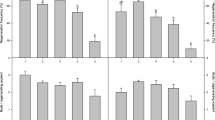Summary
Tissue cultures capable of plant regeneration were successfully initiated from extremely immature shoot meristems of 21 randomly selected genotypes of wheat on nutrient media containing 2,4-dichlorophenoxyacetic acid (2,4-D). By means of scanning electron microscopy it was demonstrated that cultures consisted of teratomatous primordia, which were kept in a proliferating budding state by the 2,4-D. These are characteristic of cereal tissue cultures. Release of the primordia and outgrowth of normal shoots and roots occurred when the cultures were no longer exposed to 2,4-D. Shoot primordia which were clearly identifiable were always associated with root primordia in a quasi-bipolar fashion. Sometimes regions assumed the shape of zygotic embryos, but the transition from apparently normal embryos with scutellum to abnormal configurations with shoot and root regions was gradual. The differences between genotypes in shoot regeneration potential was minimal compared to cultures derived from explants which were taken from regions temporally and spatially more distant from the shoot apex. It is concluded that the ability to give rise to cultures capable of shoot regeneration was lost within a fraction of a millimeter distance from the apical meristem in many genotypes. The proliferating tissues were subcultured at regular intervals over a period of one year and the regeneration potential was monitored. Areas capable of shoot regeneration tended to deteriorate more or less rapidly and were overgrown by root-type tissue in a number of genotypes. The results are discussed in the context of the frequently observed, but largely unexplained, variability in the regeneration potential of cereal tissue cultures.
Similar content being viewed by others
References
Bhojwani, S. S., Hayward, C., 1977: Some observations and comments on tissue culture of wheat. Z. Pflanzenphysiol.85, 341–348.
Cure, W. W., Mott, R. L., 1978: A comparative study of organogenesis in cultured tissues of maize, wheat and oats. Physiol. Plant.42, 91–96.
Dunstan, D. J., Short, K. C., Dhaliwal, H., Thomas, E., 1979: Further studies on plantlet production from cultured tissues ofSorghum bicolor. Protoplasma101, 355–361.
Kawata, S., Ishihara, A., 1968: The regeneration of rice plantOryza sativa L. in the callus derived from the seminal root. Proc. Japan Acad.44, 549–553.
King, P. J., Potrykus, I., Thomas, E., 1978:In vitro genetics of cereals: Problems and perspectives. Physiol. Vég.16, 381–399.
Llewellyn, D., Brettell, R., 1985: Potential for genetic manipulation to improve the production of crop and pasture plants. In: Reviews in Rural Science No. 6, Biotechnology and Recombinant DNA Technology in the Animal Production Industries, pp. 163–175. Armidale: University of New England.
Murashige, T., Skoog, F., 1962: A revised medium for rapid growth and bioassay with tobacco tissue cultures. Physiol. Plant.15, 473–497.
O'Hara, J. F., Street, H. E., 1978: Wheat callus culture: The initiation, growth and organogenesis of callus derived from various explant sources. Ann. Bot.42, 1029–1038.
Ozias-Akins, P., Vasil, I. K., 1982: Plant regeneration from cultured immature inflorescences ofTriticum aestivum L. (wheat): Evidence for somatic embryogenesis. Protoplasma110, 95–105.
Thomas, E., Brettell, R., Wernicke, W., 1980: Problems in plant regeneration from protoplasts of important crops. In: Advances in Protoplast Research (Ferenczy, L., Farkas, G. L., eds.), pp. 269–273. Budapest: Akademiai Kiado.
Vasil, V., Lu, C.-Y., Vasil, I. K., 1985: Histology of somatic embryogenesis in cultured immature embryos of maize (Zea mays L). Protoplasma127, 1–8.
Wernicke, W., Brettell, R. I. S., 1982: Morphogenesis from cultured leaf tissue ofSorghum bicolor—Culture initiation. Protoplasma111, 19–27.
—,Milkovits, L., 1984: Developmental gradients in wheat leaves—Response of leaf segments in different genotypes culturedin vitro. J. Plant Physiol.115, 49–58.
—,Potrykus, I., Thomas, E., 1982: Morphogenesis from cultured leaf tissue ofSorghum bicolor—The morphogenetic pathways. Protoplasma111, 53–62.
Author information
Authors and Affiliations
Rights and permissions
About this article
Cite this article
Wernicke, W., Milkovits, L. The regeneration potential of wheat shoot meristems in the presence and absence of 2,4-dichlorophenoxyacetic acid. Protoplasma 131, 131–141 (1986). https://doi.org/10.1007/BF01285035
Received:
Accepted:
Issue Date:
DOI: https://doi.org/10.1007/BF01285035




